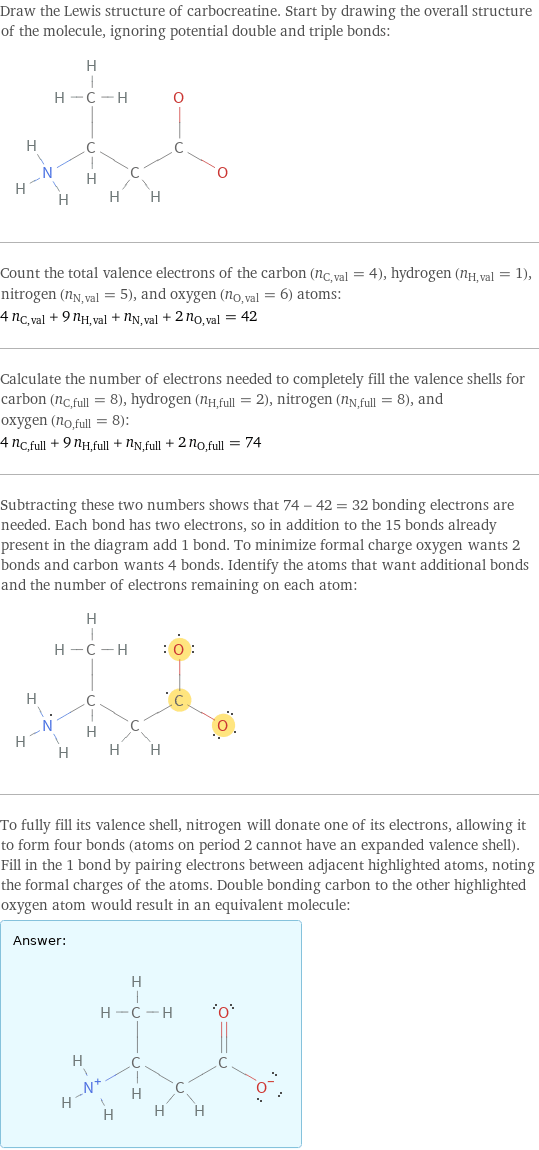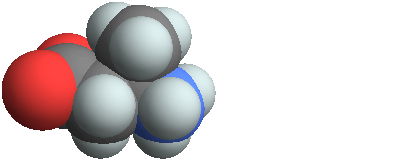Input interpretation

carbocreatine
Chemical names and formulas

formula | C_4H_9NO_2 name | carbocreatine IUPAC name | (3R)-3-azaniumylbutanoate alternate names | 3-methyl-B-alanine | DL-3-aminobutanoic acid | DL-3-aminobutyric acid mass fractions | C (carbon) 46.6% | H (hydrogen) 8.8% | N (nitrogen) 13.6% | O (oxygen) 31%
Lewis structure

Draw the Lewis structure of carbocreatine. Start by drawing the overall structure of the molecule, ignoring potential double and triple bonds: Count the total valence electrons of the carbon (n_C, val = 4), hydrogen (n_H, val = 1), nitrogen (n_N, val = 5), and oxygen (n_O, val = 6) atoms: 4 n_C, val + 9 n_H, val + n_N, val + 2 n_O, val = 42 Calculate the number of electrons needed to completely fill the valence shells for carbon (n_C, full = 8), hydrogen (n_H, full = 2), nitrogen (n_N, full = 8), and oxygen (n_O, full = 8): 4 n_C, full + 9 n_H, full + n_N, full + 2 n_O, full = 74 Subtracting these two numbers shows that 74 - 42 = 32 bonding electrons are needed. Each bond has two electrons, so in addition to the 15 bonds already present in the diagram add 1 bond. To minimize formal charge oxygen wants 2 bonds and carbon wants 4 bonds. Identify the atoms that want additional bonds and the number of electrons remaining on each atom: To fully fill its valence shell, nitrogen will donate one of its electrons, allowing it to form four bonds (atoms on period 2 cannot have an expanded valence shell). Fill in the 1 bond by pairing electrons between adjacent highlighted atoms, noting the formal charges of the atoms. Double bonding carbon to the other highlighted oxygen atom would result in an equivalent molecule: Answer: | |
3D structure

3D structure
Basic properties

molar mass | 103.12 g/mol phase | solid (at STP) melting point | 218 °C solubility in water | very soluble
Units

Chemical identifiers
![CAS number | 2835-82-7 Beilstein number | 1720564 PubChem CID number | 6994717 SMILES identifier | CC(CC(=O)[O-])[NH3+] InChI identifier | InChI=1/C4H9NO2/c1-3(5)2-4(6)7/h3H, 2, 5H2, 1H3, (H, 6, 7)/t3-/m1/s1/f/h5H EU number | 220-617-0 NSC number | 77380](../image_source/6fda2f23be5c5ec5e1ecc793b26bea71.png)
CAS number | 2835-82-7 Beilstein number | 1720564 PubChem CID number | 6994717 SMILES identifier | CC(CC(=O)[O-])[NH3+] InChI identifier | InChI=1/C4H9NO2/c1-3(5)2-4(6)7/h3H, 2, 5H2, 1H3, (H, 6, 7)/t3-/m1/s1/f/h5H EU number | 220-617-0 NSC number | 77380